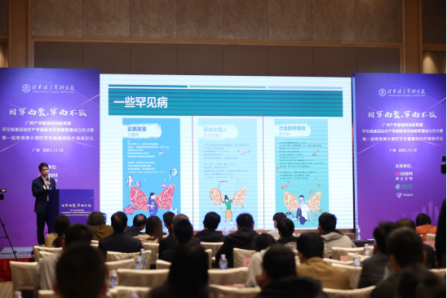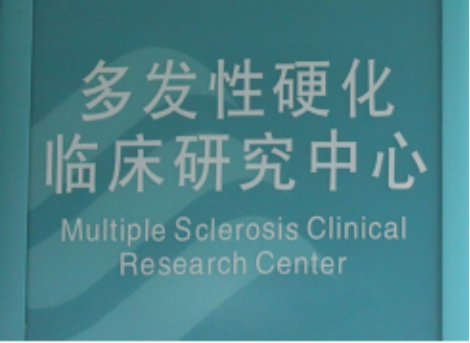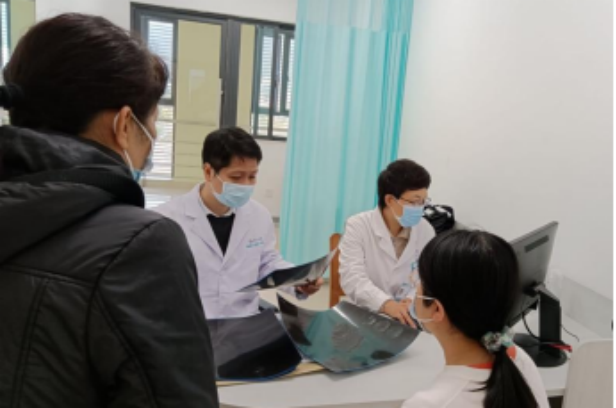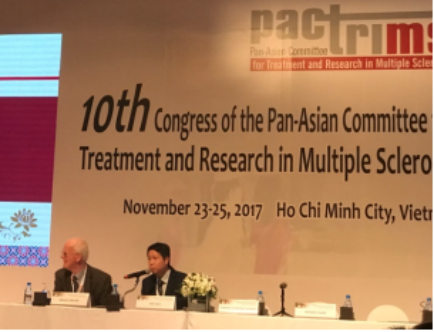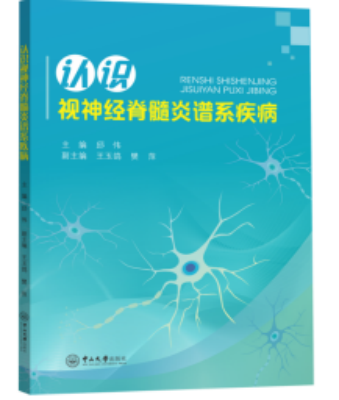Professor Qiu Wei: Early diagnosis and treatment can improve the prognosis of patients with autoimmune rare diseases, and rare diseases need to "be seen"
Question 1: What are the most common neuroimmune rare diseases that you encounter in your clinical work? Can you share some memorable stories from your clinical work?
Professor Qiu: Many neuroimmune diseases are rare diseases, including multiple sclerosis, neuromyelitis optica spectrum disorders, autoimmune encephalitis, systemic myasthenia gravis, IgG4-related diseases, POEMS syndrome, which have been included in the "First Batch of Rare Disease Catalog" in China. These diseases are frequently encountered in our hospital's neuroimmune disease center. These rare diseases often do not receive enough attention and are prone to misdiagnosis or delayed diagnosis.
Figure 1. Professor Qiu Wei spreading awareness about rare diseases during a lecture at the Guangzhou Rare Disease Gene Therapy Alliance.
One typical example of misdiagnosis or delayed diagnosis in clinical work is neuromyelitis optica spectrum disorders (NMOSD). This disease is a recurrent neuroimmune disease, and patients often have residuals of neurological disabilities after each attack, so early diagnosis and treatment are crucial for improving patient prognosis.
Some NMOSD patients have onset with intractable hiccups and vomiting, which clinically manifests as the area postrema syndrome, and these patients are often initially diagnosed by gastroenterologists due to a lack of awareness. In the past, these patients were often misdiagnosed with psychiatric illnesses due to a lack of diagnosis based on comprehensive examination of the digestive system. It was not until the appearance of more serious symptoms such as visual impairment and movement disorders caused by optic nerve and spinal cord lesions that they were referred to a neurology department. However, at this point, the optimal diagnosis and treatment time had been missed, resulting in irreversible disabilities. In recent years, due to increased awareness of rare diseases, internal medicine physicians have gradually improved their understanding of these conditions. Some internal medicine physicians have considered NMOSD as a rare disease and have conducted specific biological marker tests, such as AQP4-IgG, in clinical treatment, enabling patients to receive early diagnosis and treatment.
Stiff person syndrome is also a disease that is easy to misdiagnose and needs to be differentiated from conditions such as ankylosing spondylitis and hysteria. In 2020, I and Professor Hu Xueqiang of our department treated a 44-year-old stiff person syndrome patient who had been ill for 5 years and had visited multiple departments in other places for treatment. Routine examination, tumor-related examination, inflammation and rheumatism-related examination, endocrine-related examination, metabolism-related examination, and even genetic testing did not show any significant abnormalities. After GAD65 antibody testing was performed, abnormalities were found and the patient was diagnosed. After diagnosis, we used blood purification to treat her, and later used immunosuppressive agents. Today, the patient has improved significantly, and her quality of life has improved. Generally speaking, the awareness of rare diseases among clinical physicians is still far from sufficient, and we still have a long way to go.
Question 2: What is the current situation of prevention and treatment for neuroimmune rare diseases in China? As an industry expert, what are your suggestions for the prevention and screening of rare diseases?
Professor Qiu: Historically, we have not given enough importance to rare diseases, and clinical physicians have limited knowledge and experience in diagnosing and treating these conditions, making diagnosis difficult. In addition, some patients with clear diagnoses have not received effective treatment due to a lack of available medication or high medication costs. Fortunately, in recent years, the government's strong policies, as well as education and public awareness campaigns, have gradually increased the awareness of rare diseases among clinical physicians and the public.
In terms of diagnostic and treatment standards, in May 2018, five government departments, including the National Health Commission, the Ministry of Science and Technology, the Ministry of Industry and Information Technology, the State Administration for Market Regulation, and the State Administration of Traditional Chinese Medicine, jointly released the "First Batch of Rare Diseases" catalog in China, which covers 121 rare diseases, including nearly 10 diseases related to neuroimmunology. Based on this catalog, the National Health Commission organized the Rare Diseases Diagnosis and Treatment and Guarantee Expert Committee Office to lead the development of the "Rare Disease Diagnosis and Treatment Guidelines (2019 Edition)." This publication provides specific treatment guidelines for each of the 121 rare diseases included in the "First Batch of Rare Diseases" catalog. The guidelines provide detailed definitions, epidemiology, etiology, clinical manifestations, auxiliary examinations, diagnosis, differential diagnosis, treatment, and specific diagnostic and treatment procedures for each rare disease. The release of the rare disease catalog and diagnosis and treatment guidelines has strengthened the management of rare diseases in China, improved the standardization level of diagnosis and treatment of rare diseases, ensured the quality and safety of medical services for rare disease patients, and safeguarded the health rights and interests of rare disease patients.
In terms of disease management, in February 2019, the National Health Commission announced the establishment of a national rare disease diagnosis and treatment collaboration network. The network consists of 324 hospitals that have strong rare disease diagnosis and treatment capabilities and treat a large number of rare disease cases, including 1 national-level lead hospital, 32 provincial-level lead hospitals, and 291 member hospitals of the collaboration network. Zhongshan Hospital affiliated to Sun Yat-sen University, where our neuroimmune center is located, is also a member of the national rare disease diagnosis and treatment collaboration network. Hospitals within the collaboration network have established smooth and efficient collaboration mechanisms, providing relatively centralized diagnosis and treatment for rare disease patients and bi-directional referral to fully leverage high-quality medical resources and improve China's comprehensive rare disease diagnosis and treatment capabilities which will eventually lead to the goal of early detection, early diagnosis, treating rare diseases and drafting disease management plans. Later in November 2019, to implement the "establishment of a rare disease patient registration system," the Commission developed the Chinese Rare Disease Diagnosis and Treatment Service Information System and organized the member hospitals of the national rare disease diagnosis and treatment collaboration network to register rare disease case diagnosis and treatment information. As of February 2022, the system has collected information on approximately 500,000 rare disease patients. This information system collects relevant data, which is useful for understanding the epidemiology, clinical diagnosis, treatment and medical security status of rare diseases in China. It provides scientific evidence for developing population intervention strategies, improving the diagnosis and treatment service system, improving the level of medical security for patients, and improving drug accessibility.
In terms of therapeutic drugs, there has been a lack of therapeutic drugs for rare diseases in the past. Due to the small number of rare disease cases and limited research resources, the development of drugs for rare diseases has been difficult, and even those that have been developed are often unaffordable for most patients. Fortunately, the State Drug Administration has been highly concerned about the medication needs of rare disease patients, continuously deepening drug approval and review system reforms, supporting the research and development of rare disease drugs, and has approved 56 rare disease drugs for marketing from 2018 to now. In addition, the National Medical Security Administration attaches great importance to the medical security of rare disease patients and focuses on the level of medical insurance coverage for rare disease drugs while adhering to the basic function of medical insurance. In the 2022 national medical insurance drug catalog revision, a separate application channel was established for rare disease drugs, which supports their priority entry into the medical insurance catalog. Currently, 45 rare disease drugs have been included in the medical insurance drug catalog, covering 26 rare diseases, and their prices have been lowered through access negotiations.
Under the guidance of the above policies and measures, some clinical physicians have gradually become aware of various rare diseases and have improved their awareness of the diagnosis and treatment of rare diseases. However, overall, the understanding of rare diseases among medical personnel is not yet sufficient, and there are still cases of missed or misdiagnosed rare diseases. To address these problems, continuing education and training can be conducted for medical personnel to improve their standardized diagnosis and treatment capabilities for rare diseases, helping rare disease patients receive early diagnosis and treatment and improving their prognosis.
Question 3: Three years ago, you established a follow-up clinic for multiple sclerosis (MS) patients and established follow-up records for MS patients. How many cases have been collected so far? How effective has disease control been through follow-up and personalized treatment plans?
Professor Qiu: After more than 20 years of accumulation, our hospital's MS follow-up clinic has established follow-up records for thousands of patients, including MS and other neuroimmune diseases. Through follow-up and personalized treatment plans, most of these MS patients have obtained good prognosis.
Figure 2. Sun Yat-sen Third Hospital established the "Multiple Sclerosis Clinical Research Center," which was the first of its kind in China.
First, we need to explain the course and characteristics of multiple sclerosis (MS). Unlike the neuromyelitis optica spectrum disorders mentioned earlier, MS is a lifelong disease that often takes on a relapsing-remitting course in the beginning. During relapse periods, patients experience significant clinical symptom worsening and seek medical treatment. However, in addition to clinical relapses, MS also has many subclinical relapses that gradually increase the burden of lesions on the patient's nervous system and worsen the patient's condition. Furthermore, as the disease progresses, patients can experience disease progression independent of relapses and gradually worsen their neurological disabilities. Without regular follow-up, patients may miss the opportunity for timely diagnosis and treatment of these disease changes.
Based on the above characteristics of MS, close clinical follow-up and personalized treatment plans can prevent and reduce relapses, monitor clinical/subclinical relapses, and minimize neurological damage during relapse periods. It can also monitor disease progression, detect signs of disease progression early, and maintain a patient's neurological function during remission periods. Additionally, due to long-term medication, drug safety monitoring is also an important part of follow-up. Therefore, our clinical practice has confirmed that developing accurate and safe treatment strategies through long-term regular follow-up is an important measure to improve the overall patient prognosis.
Our Neuroimmunology Center recently participated in an international research project called "Global Distribution of Multiple Sclerosis." We analyzed the data from our center and found that the long-term use of disease-modifying therapies (DMTs) among multiple sclerosis patients in Guangzhou has been increasing annually, compared to only a few patients using DMTs during remission in 2019. The overall rate of DMT usage among our center's patients has also exceeded 80%. Multiple sclerosis patients who use DMTs have significantly lower relapse rates and improved clinical scores.
Figure 3. Professor Qiu Wei's Multiple Sclerosis Follow-up Clinic.
Question 4: You recently cured an extremely rare case of Moersch-Woltman syndrome. How long was the treatment course from start to finish? In your opinion, what are the diagnostic and therapeutic challenges of Moersch-Woltman syndrome?
Professor Qiu: This case was quite complicated and rare. The patient was a young woman who came to us with a complaint of "persistent pain and numbness in all four limbs for more than a month" and also suffered from other uncomfortable symptoms such as "insomnia, irritability, and muscle twitches all over the body". She had previously been to multiple departments in other hospitals, but the diagnosis was unclear and the treatment was ineffective. After being transferred to our neurology department for further treatment, we conducted detailed questioning, physical examination, and relevant auxiliary examinations. Finally, we found that the patient had a specific antibody called Caspr2 antibody in the blood and cerebrospinal fluid, and the antibody titer was high. Multiple abnormal inflammatory lesions were also found in the erector spinae muscles on MRI. Combining the patient's medical history and the results of electrophysiological and imaging examinations, we confirmed the diagnosis of "Moersch-Woltman syndrome". The patient's symptoms improved after receiving pulse steroid therapy and she was discharged from the hospital. She continued to take oral steroids for maintenance. The treatment for this case, from diagnosis to complete cure, took about one month.As for the diagnostic and therapeutic challenges of Moersch-Woltman syndrome, the syndrome is a rare autoimmune disorder that affects the nervous system and can result in a variety of neurological symptoms. The diagnosis is often difficult and requires a high degree of clinical suspicion. The treatment usually involves immunosuppressive therapy such as steroids, but the optimal duration and regimen of treatment are still under investigation. Additionally, the prognosis is highly variable and can be difficult to predict.
Moersch-Woltman syndrome is an extremely rare autoimmune disease that primarily affects the muscles and presents with irregular contractions, painful spasms, weakness, sweating, limb itching, insomnia, and mental confusion. The disease can also affect the central nervous system, peripheral nervous system, and autonomic nervous system, resulting in various clinical manifestations. Due to the diverse clinical symptoms of the disease, it is difficult for first-line physicians to diagnose accurately. Additionally, the specific Caspr2 antibody is crucial for diagnosis, making it easy to miss the diagnosis in facilities without antibody testing capabilities.
Question 5: Neuroimmunological diseases are one of your research interests. What related research are you currently working on? What is the progress so far? What is the biggest challenge in the research process?
Professor Qiu: Our research group is based at the Brain Disease Center of the Third Affiliated Hospital of Sun Yat-sen University. We conduct clinical diagnosis and treatment and basic research of various neuroimmunological diseases of the central and peripheral nervous systems through the mutual support of clinical treatment centers and basic research platforms. The diseases we mainly focus on include demyelinating diseases of the central nervous system, autoimmune encephalitis, Guillain-Barré syndrome, myasthenia gravis, and paraneoplastic syndromes, among others.
Figure 4. Group photo of students in Professor Qiu Wei's research group.
Taking multiple sclerosis and neuromyelitis optica spectrum disorders as examples of inflammatory demyelinating diseases, our research group conducts basic and clinical translational research focusing on key scientific issues such as "central-peripheral immune interaction", "genetic-immune interaction", "blood-brain barrier function" and "central glial cell functional regulation".In terms of clinical research, our research group has established patient follow-up cohorts and case databases for many years. Recently, we also led a epidemiological study of multiple sclerosis in 16 tertiary hospitals in Guangzhou, filling the gap in this area. In terms of basic research, our specific research areas include disease susceptibility genes, biological markers, new treatment targets and strategies based on pathogenesis, providing theoretical support for personalized treatment of the disease.Recently, our research group discovered that the susceptibility gene for sporadic cases of neuromyelitis optica spectrum disorders is HLA-DPB1*05:01, while the susceptibility of familial cases may be related to the USP18 gene. Our developed technique for detecting anti-myelin oligodendrocyte glycoprotein antibodies (MOG-IgG) has important diagnostic and disease monitoring implications.In terms of treatment strategies, our research group conducted basic research on a series of candidate targets represented by CD44, and used the hospital's nanomedicine platform to transform small molecules using nanotechnology to explore new treatment approaches. At the same time, our research group has developed stable and reliable animal models of neuroimmunological diseases to validate our research findings, which are helpful for clinical translational of basic research results.
Currently, the biggest challenge in clinical research is still the limited number of cases of rare diseases. Our Neuroimmunology Center's follow-up clinics and some multicenter collaborative studies can help patients with long-term disease monitoring and help researchers obtain more complete disease data, which is expected to solve this problem.
Question 6: What do you think is the biggest challenge in developing drugs for rare diseases? How do you view cell and gene therapy? What is your opinion on the prospect of gene therapy for rare neuroimmunological diseases?
Professor Qiu: The biggest challenge in developing drugs for rare diseases may lie in the contradiction between the rarity of the disease and its heterogeneity. The prevalence of rare diseases is less than 1/100,000, so the number of patients with the same rare disease is limited, and resources for drug development and research are restricted. On the other hand, some rare diseases often exhibit heterogeneous clinical phenotypes and treatment outcomes due to the combination of multiple factors such as genetics and environment.
Gene therapy and cell therapy are newly developed treatment methods in recent years, and are also one of the current research hotspots. They both involve introducing exogenous substances (genes/cells) into the patient's body to restore normal physiological functions and achieve a new balance state of the body. This is a completely different treatment approach from traditional drugs or surgeries, focusing on the cause and the global perspective of the disease. Of course, these therapies are still in the exploration stage, and there may still be some unresolved issues. But we believe that with the unremitting efforts of experts and scholars, relevant theories and technologies will continue to progress, and the best balance point for these issues will be found. These two treatment methods will have great clinical application potential.
Regarding the application of gene therapy to rare diseases, given that many rare diseases are genetic or involve genes associated with genetic susceptibility, gene therapy should have broad prospects in the treatment of rare diseases. Especially for some rare monogenic diseases, gene therapy is the most suitable. For example, the antisense oligonucleotide technology in gene therapy is the most typical example of using gene therapy to treat rare diseases in the nervous system, and has been applied in spinal muscular atrophy. Spinal muscular atrophy has been included in China's "First Batch of Rare Diseases" catalogue, and its drug, nusinersen sodium, treats SMN protein defects caused by chromosome 5q mutations through antisense oligonucleotide technology.
In December 2021, nusinersen sodium injection was officially included in the medical insurance, reducing the cost from 700,000 RMB to 30,000 RMB, allowing many patients to have access to treatment. Our hospital's Zhaoqing Branch also administered the first injection for a spinal muscular atrophy patient in Zhaoqing in September. Therefore, the prospect of gene therapy in the treatment of rare diseases is unlimited.
Question 7: Your research accomplishments such as AQP4-IgG and MOG-IgG have been translated into clinical applications. What conditions do you think are required to translate laboratory research into clinical applications? Please share your experience.
Professor Qiu: To translate laboratory research into clinical applications, it is necessary to start with and return to the clinical needs. During the design stage of laboratory research, especially in the design of scientific questions, the scientific questions to be solved must be urgently needed and clinically significant. For example, the series of neuroimmunological disease-related antibody testing developed by our Neuroimmunology Center, including oligoclonal band detection for multiple sclerosis and AQP4-IgG detection for neuromyelitis optica spectrum disorders that were initiated more than ten years ago, as well as MOG-IgG detection and other antibody tests for autoimmune encephalitis, paraneoplastic syndrome, peripheral nerve diseases, and myasthenia gravis that have been gradually developed in recent years are all designed to serve clinical disease diagnosis, differential diagnosis, monitoring of disease status and treatment effectiveness. These scientific questions derived from clinical practice can be directly translated into clinical applications after obtaining results in laboratory research, benefiting patients and serving clinical needs.
Question 8: Currently in China, medical insurance reform ("Guotan") is underway, and the call to include more orphan drugs in medical insurance coverage has been high among industry insiders. How do you view this matter?
Professor Qiu: Rare disease patients have long been in a situation of inadequate medical treatment and drugs. Due to the low incidence of rare diseases, limited research resources, a relatively small market for treatment drugs, difficulties in drug development, and high prices, the significant promotion role of "Guotan" in including rare disease treatment drugs in medical insurance is a great blessing for rare disease patients, as many previously untreatable rare diseases now have drugs available. According to information from the 2022 Rare Disease Conference, since 2018, 19 new rare disease drugs have been added to the medical insurance list through negotiations, with an average price reduction of 52.6%. Take Guangzhou medical insurance as an example, many multiple sclerosis patients could not afford disease-modifying therapy due to financial reasons before 2018. Since disease-modifying drugs for multiple sclerosis were added to the medical insurance list in 2018, the monthly cost after drug reimbursement of nearly 10,000 yuan was reduced to just over 1,000 yuan. Many patients can now afford the treatment cost, stabilize their condition, and improve their quality of life.
Question 9: You have studied and exchanged ideas in Australia, the United States, and other regions. Based on your personal experience, in your opinion, what gaps exist between China and other countries in the prevention and treatment of rare diseases, and how can these gaps be bridged?
Professor Qiu: China's rare disease prevention and treatment is still in its early stages. Clinical physicians have limited knowledge of rare diseases and do not always consider these rare diseases in their clinical diagnosis and treatment, leading to missed or misdiagnosis of rare diseases. In addition, the registry system and research database for rare diseases are not yet mature. Taking the example of multiple sclerosis patients in Australia, patients who are not diagnosed by primary care doctors are referred to neurologists. After the diagnosis is confirmed by a specialist physician, multiple sclerosis patients are managed by a dedicated medical specialist, and the data is registered in a national unified database. From a micro perspective, patients can clarify their disease stages and choose appropriate diagnosis and treatment methods by comparing their own data with national data. From a macro perspective, analysis of national data can reveal the unique clinical characteristics of multiple sclerosis patients in the country. Through the recent emphasis on rare diseases by the Chinese government and a series of measures implemented, clinical physicians' understanding of rare diseases is gradually improving in China. At the same time, China has established a national rare disease diagnosis and treatment collaboration network consisting of 324 hospitals, and established the China Rare Disease Diagnosis and Treatment Service Information System based on it. China's rare disease management and registration work are being carried out in an orderly manner. I believe that the gap between China and other countries in the prevention and treatment of rare diseases will gradually narrow.
Figure 5. Professor Qiu Wei exchanging knowledge and experience on multiple sclerosis with international peers.
Question 10: What is your opinion on China's establishment of its own national rare disease database? In your opinion, what are the necessary conditions for a good database, and do you have any suggestions for improving the Rare Diseases Database of China (RDDC)?
Professor Qiu: It is very necessary to establish our own national rare disease database in China. Due to the differences in ethnicity, the incidence of rare diseases in foreign populations is not completely identical to that of the Chinese population. Rare diseases in the Chinese population may have different susceptibility gene types, clinical characteristics, treatment effects, and prognosis compared to foreign populations. For example, the neuromyelitis optica spectrum disorder (NMOSD) that our Neuro-Immunology Center frequently diagnoses is very rare worldwide and lacks foreign research data. However, NMOSD is relatively high in incidence among the Asian population. In China, the incidence rate is (3-5)/(100,000 person-year), and considering the country's large population, there is a substantial number of patients with NMOSD. Therefore, it is urgent for China to independently conduct research on treatment strategies for NMOSD. Similarly, other rare diseases also urgently need to establish databases in China to help determine the clinical characteristics and treatment responses of Chinese patients, and improve patient prognosis.
Figure 6. Professor Qiu Wei as the chief editor of the first domestic book on Neuromyelitis Optica Spectrum Disorders.
Database design is a broad topic encompassing the inclusion of indicators, data entry, data statistics, and data retrieval. However, from the perspective of rare diseases, compatibility is one of the most important aspects of database design. Due to the low incidence of rare diseases, clinical centers have limited case resources and require multicenter studies to increase sample size to better observe patients' clinical characteristics and guide diagnosis and treatment. In this regard, the Rare Disease Diagnosis and Treatment Service Information System developed by the National Health Commission adopted unified data formats and standards and organized member hospitals of the National Rare Disease Diagnosis and Treatment Collaboration Network to perform rare disease case diagnosis and treatment information registration to achieve consistency of multicenter data. This is a milestone in the development of clinical rare disease databases.
Another comprehensive and highly practical rare disease basic and clinical research database is the Rare Diseases Data Center (RDDC). It integrates global data on epidemiology, drug development, disease genes, disease animal models, and other information. Based on the collection, restructuring, and integration of rare disease data, RDDC presents multidimensional data with emphasis on disease, genes, and animal models. In addition, utilizing genetic big data resources, RDDC has established genetic disease-related gene diagnostic tools based on artificial intelligence and bioinformatics technology. In the subsequent construction and improvement of the database, if more Chinese population data can be integrated to summarize specific features of rare diseases in the Chinese population, it will be more beneficial to help Chinese rare disease patients develop personalized diagnosis and treatment strategies.
Expert Introduction
Figure 7. Professor Qiu Wei.
Assistant to the President, Director of Human Resources Department, Deputy Director of Neurology, Director of Office of Mental and Neurological Diseases Research Center (Brain Center), Professor, Chief Physician, and Doctoral Supervisor at the Third Affiliated Hospital of Sun Yat-sen University. Engaged in clinical and scientific research on neurological diseases for 24 years, with a main research direction focused on the etiology and clinical studies of neuroimmunological diseases (genetic and immune) including epidemiology, imaging, and clinical drug trials.
Rare Companion
"Rare Companion" is an interview program co-produced by the Guangzhou Rare Disease Gene Therapy Alliance and Southern Medicine Network. The program invites authoritative experts, researchers, entrepreneurs, and others in the rare disease field to conduct interviews on the latest research, technological advancements, clinical prevention and treatment, and other aspects related to rare diseases. It provides industry professionals and researchers with popular science knowledge and frontier information on rare diseases, and helps promote the diagnosis and treatment of rare diseases.
